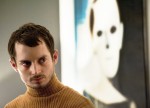Watching “Maniac” feels like a descent into psychosis.
In this fresh remake of William Lustig’s 1980s horror cult classic “Maniac,” director Franck Khalfoun revives the slasher genre with point-of-view filming and a new take on the killer profile.
The low-budget genre film stays true to the spirit of the original, following Frank (Elijah Wood), the quiet owner of a vintage mannequin shop. Frank takes solace in only two things: restoring his mannequins and murdering beautiful women for their scalps. When Frank falls for photographer Anna’s (Nora Arnezeder) innocence and beauty, a romantic storyline blooms in the middle of a horrific backdrop.
Paramount among Khalfoun’s many daring stylistic decisions is the choice to film from the first-person point of view. For nearly the entirety of “Maniac,” the viewer witnesses Frank’s shifts from sanity to lunacy from an eye-level seat. More impressively, the camera perfectly mimics Wood’s movements for a truly authentic point of view.
While the unusual perspective is sometimes distracting or irritating, it transforms this slasher into an experience rather than just a film. Peering through Frank’s eyes, the audience sees every hairy detail as he rips women’s scalps off using a small straight razor.
In these close-up shots, the special effects are dazzling. The realistic gore keeps the torture and slaughter from feeling contrived. From vomit to scalps to frequent disembowelment, the film is excellently disgusting.
While Khalfoun’s camera shots clear up the mysteries of Frank’s mental state, the poignant music transports the audience to an ambient environment of film watching. During Frank’s episodes, the music takes a haunting turn, reminiscent of an edgy, techno music box. The music blares in time with a high-pitched, maddening whine while Wood talks to himself.
The character development and dialogue in “Maniac,” sadly, are subpar, but do not significantly weigh down the movie. Without the variation of the point-of-view camera technique, none of it would really work. Yet, because of the sometimes confusing shots, the bare-bones conversations and clichéd exclamations help guide the story.
All the women in the film are depicted one-dimensionally as either good or bad. Although the film breaks Frank’s neurosis down through a series of flashbacks to some deep-rooted issues involving his mother, his behavior and motivations are still a little hazy by the end of the film.
Khalfoun’s interpretation of the slasher genre’s killer character, however, is compelling.
Instead of the original film’s greasy, overweight monster of a man, Khalfoun makes Frank out to be a shy and considerate character, akin to Alfred Hitchcock’s Norman Bates from “Psycho.” Unlike slasher psychopaths of the past, such as Freddie Krueger or Ghostface, Frank shows remorse and internal conflict with his compulsion to kill.
Wood gives a brilliant performance and hits all the right notes as both the boy next door and a dangerous murderer. Although he rarely shows up on screen, he commands attention. In the few shots where Wood is visible, the viewer sees him through reflections in windows and mirrors as he sees himself. His piercing blue eyes come to life in these shots, especially when he’s in the middle of a kill.
Likewise, Arnezeder is effervescent on screen. Usually bathed in light, she has an effortless innocence and beauty. Her captivating facial expressions come to life in the close first-person shots. While coming off as sweet at times, she isn’t the average damsel in distress and gives a believable performance as she fights for her life.
As Khalfoun’s depiction modernizes Lustig’s original, it also shows a different side of slasher films. In essence, it’s all been done before, but not quite like this. For those looking for an extremely intimate, artistic gore fest, this is the film to see.
